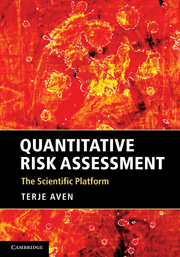Book contents
- Frontmatter
- Contents
- Preface
- Acknowledgments
- 1 Introduction to risk management and risk assessments. Challenges
- 2 Concepts and perspectives on risk
- 3 Science and scientific requirements
- 4 Introduction to case studies
- 5 Risk assessment when the objective is accurate risk estimation
- 6 Risk assessment when the objective is uncertainty descriptions
- 7 Risk management and communication issues
- 8 Towards a holistic scientific approach to risk assessment
- 9 Conclusions
- Appendix A Introduction to probability theory and statistical analysis
- Appendix B Terminology
- References
- Index
2 - Concepts and perspectives on risk
Published online by Cambridge University Press: 05 June 2012
- Frontmatter
- Contents
- Preface
- Acknowledgments
- 1 Introduction to risk management and risk assessments. Challenges
- 2 Concepts and perspectives on risk
- 3 Science and scientific requirements
- 4 Introduction to case studies
- 5 Risk assessment when the objective is accurate risk estimation
- 6 Risk assessment when the objective is uncertainty descriptions
- 7 Risk management and communication issues
- 8 Towards a holistic scientific approach to risk assessment
- 9 Conclusions
- Appendix A Introduction to probability theory and statistical analysis
- Appendix B Terminology
- References
- Index
Summary
In this chapter we first review and discuss common definitions of risk (Section 2.1–2.6). From this review and discussion we define the concepts and perspectives of probability and risk that will be used as the basis for the risk assessments studied in Chapters 5–7 (Sections 2.7–2.8). These perspectives specify not only how risk is defined, but also how to express risk. We also include an illustrative example (Section 2.9). Basically we will distinguish between two main lines of thinking, one where risk is considered an “objective” property of the activity studied and the aim of the risk assessment is to accurately estimate this risk, and one where uncertainty is a main component of risk and the aim of the risk assessment is to describe the uncertainties. The final Section 2.10 provides a summary of key concepts and perspectives. Some basic references for this chapter are Aven (2009a,b, 2010a,e).
Risk equals expected value
The concept of risk is defined in many ways. In engineering contexts, risk is often linked to the expected loss; see e.g. Lirer et al. (2001), Mandel (2007), Verma and Verter (2007) and Willis (2007). However, such an understanding of risk means that there is no distinction made between situations involving potential large consequences and associated small probabilities, and frequently occurring events with rather small consequences, as long as the sums of the products of the possible outcomes and the associated probabilities are equal. For risk management these two types of situations normally would require different approaches.
- Type
- Chapter
- Information
- Quantitative Risk AssessmentThe Scientific Platform, pp. 16 - 31Publisher: Cambridge University PressPrint publication year: 2011

